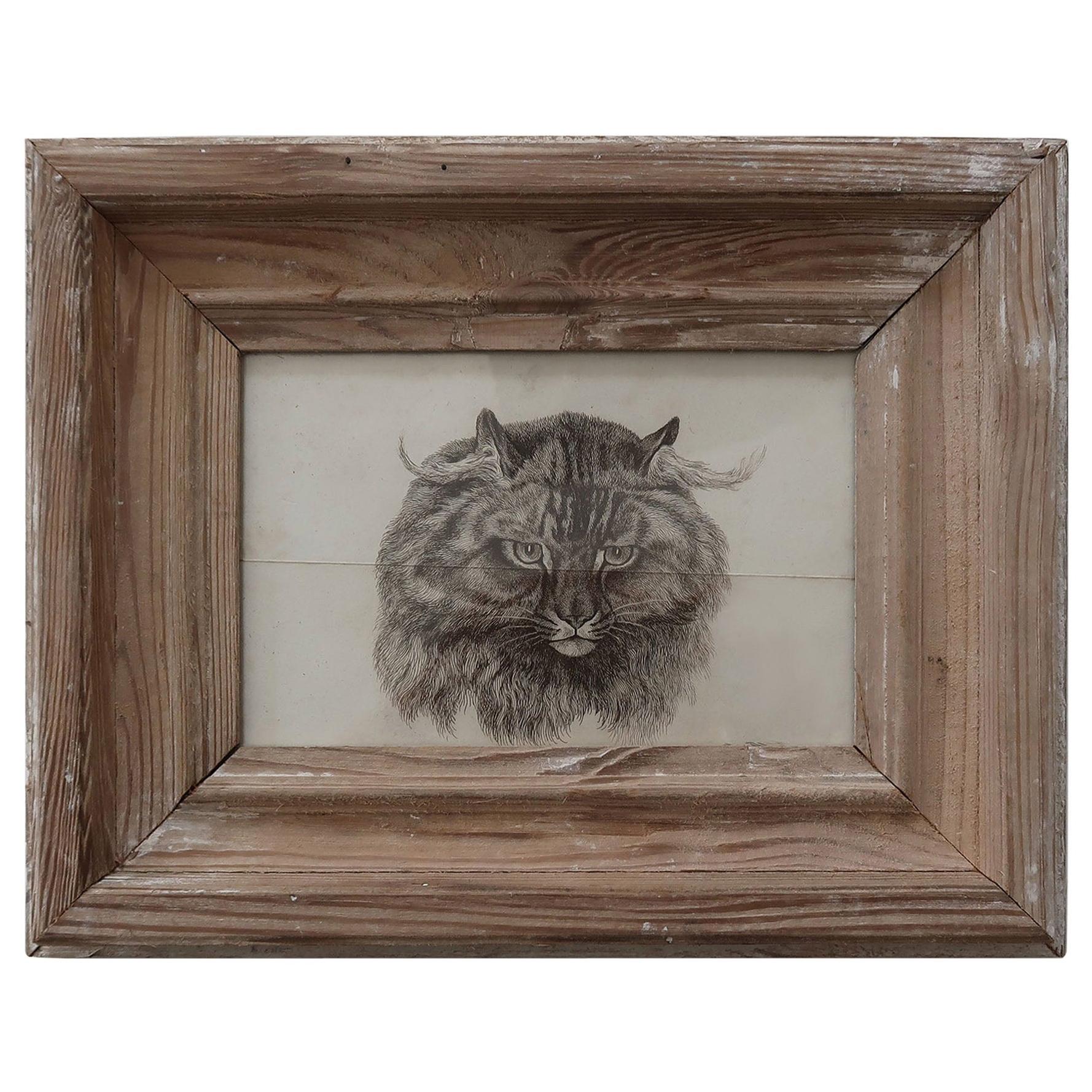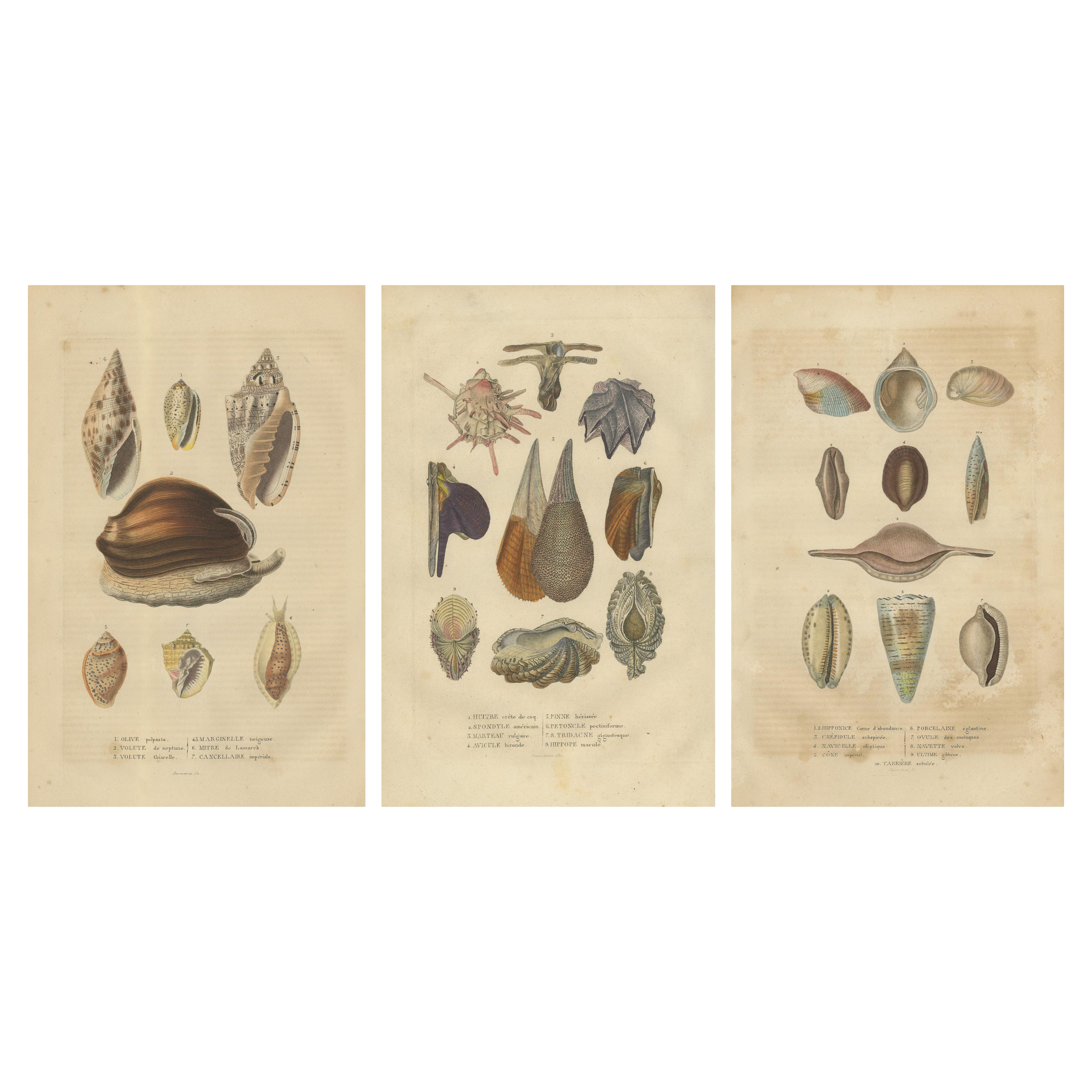Items Similar to 19th Century Lepidoptera: An Illustrated Compendium of Moths and Butterflies
Want more images or videos?
Request additional images or videos from the seller
1 of 7
19th Century Lepidoptera: An Illustrated Compendium of Moths and Butterflies
About the Item
An antique hand-colored engraving. This particular illustration focuses on various moth and butterfly species, showcasing their wing patterns and body shapes in vibrant colors and with a high level of detail.
The different specimens are numbered and named at the bottom, likely corresponding to their scientific names, which are partially legible and written in French. These include various types of moths and butterflies with distinct markings, such as eye-like spots on their wings, which are often used in nature as a form of mimicry or to ward off predators.
The artistic style is consistent with scientific illustrations of the 19th century, aimed at providing an accurate representation of the insects for study and reference. The paper shows signs of aging, indicating the historical value of the print. This type of illustration would have been a vital educational tool at the time, combining scientific interest with an appreciation for the beauty of these creatures. The illustrator has captured both the structural and aesthetic qualities of the insects, which would have been important for both scientific taxonomy and for those with a general interest in natural history.
The image appears to be a caption section from an antique hand-colored engraving, listing the names of various moth and butterfly species. The names are in French and are likely to correspond to the illustrations of the specimens on the main engraving. Here's the list of the species with a description based on the names provided:
1. **SÉSIE freloniforme**: This is likely a species of clearwing moth, which mimics the appearance of a hornet or wasp (hence "freloniforme", resembling a hornet). Clearwing moths are known for their transparent wings and mimicry for defense against predators.
2. **PROCRIS du Statice**: This could refer to a species of moth or butterfly associated with sea-lavender plants (genus Statice). The genus Procris can refer to a few different things in entomology, so without additional context, it's hard to be specific.
3. **SYNTOMIDE Kuhlwein**: This might refer to a species within the Syntomidae family, known for their brightly colored wings and wasp-like appearance. The name "Kuhlwein" could be the person who either discovered the species or is otherwise associated with it.
4. **ZYGENE de l'esparcette**: This is likely a species of burnet moth (genus Zygaena), which are brightly colored and often associated with certain plants, such as sainfoin (esparcette).
5. **MACROGLOSSE bombiliforme**: This likely refers to a species of hummingbird moth (family Sphingidae), named for their resemblance to bumblebees ("bombiliforme") and their long proboscises ("macroglossa" means large-tongued).
6. **SPHÉCODINE d'abbot**: This could be a species within the Sphingidae family (hawk moths), with "d'abbot" possibly referring to the Abbot's Sphinx moth.
7. **PTÉROGON de l'énothère**: This is likely another species of hawk moth (Sphingidae), with "énothère" possibly referring to the Evening Primrose plant, which some hawk moths pollinate.
8. **DEILEPHILE du néron**: This could be a type of hawk moth, with "du néron" possibly indicating a specific host plant or region associated with this species.
9. **SMÉRINTHE oculée**: This name suggests a type of eyed hawk moth ("oculée" meaning "eyed"), known for the eye-like spots on their wings which are used to scare off predators.
The term "Desmarres S..." at the bottom might indicate the engraver, publisher, or scientist associated with the creation of the original illustration. This list provides insight into the diversity of moth and butterfly species, with a focus on their physical characteristics and ecological associations.
The hand-coloring of the print indicates that it was likely colored by an artist after printing, which was a common practice in the production of high-quality scientific books in the 19th century. The condition of the print, showing signs of aging and wear, tells us that it has been well-studied and has survived the passage of time, preserving a visual record from Drapiez's influential publication.
The style of the illustration is reminiscent of 19th-century scientific prints, which were often used in natural history books to document various species.
More info on the book in which it was published:
The 'Dictionnaire Classique des Sciences Naturelles' by Pierre Auguste Joseph Drapiez stands as a remarkable testament to 19th-century natural sciences. Published in Brussels in 1845, this work represents an expansive collation of knowledge, building upon the pioneering works of Buffon, Daubenton, Lacepede, Cuvier, de Jussieu, and other influential naturalists.
The prints within this compendium likely showcase a rich amalgamation of artistic precision and scientific accuracy. Drapiez, himself a Belgian naturalist, would have aimed for detailed representations of flora, fauna, and scientific phenomena, mirroring the illustrative styles prevalent during his time. Given the era's emphasis on illustration, these prints were likely engraved meticulously, possibly portraying intricate anatomical details or lifelike depictions of the natural world.
With Drapiez's background in natural history, the prints might bear testament to his commitment to scientific authenticity, aiming to educate and inspire scholars and enthusiasts alike. These engravings would have complemented the text, offering visual aids that elucidate the concepts and specimens discussed in the volume.
Overall, the prints of 'Dictionnaire Classique des Sciences Naturelles' likely serve as both artistic representations and invaluable scientific resources, encapsulating the essence of 19th-century natural history exploration and documentation.
- Dimensions:Height: 10.44 in (26.5 cm)Width: 6.7 in (17 cm)Depth: 0 in (0.02 mm)
- Materials and Techniques:Paper,Engraved
- Period:
- Date of Manufacture:1845
- Condition:Condition: Good. Overal toning but more foxing in the top. The images itself clean and hand-colored in expliciet colors. Light offset from a opposite text plate in the original book. Left side cut short. Please study scan carefully.
- Seller Location:Langweer, NL
- Reference Number:Seller: BG-13261-571stDibs: LU3054337751512
About the Seller
5.0
Platinum Seller
These expertly vetted sellers are 1stDibs' most experienced sellers and are rated highest by our customers.
Established in 2009
1stDibs seller since 2017
1,919 sales on 1stDibs
Typical response time: <1 hour
- ShippingRetrieving quote...Ships From: Langweer, Netherlands
- Return PolicyA return for this item may be initiated within 14 days of delivery.
Auctions on 1stDibs
Our timed auctions are an opportunity to bid on extraordinary design. We do not charge a Buyer's Premium and shipping is facilitated by 1stDibs and/or the seller. Plus, all auction purchases are covered by our comprehensive Buyer Protection. Learn More
More From This SellerView All
- Handcolored Variations of Moths: A Study in Lepidoptera Elegance, 1845Located in Langweer, NLAn original handcolored antique print featuring a series of illustrations of moths. Each moth is meticulously detailed, showcasing a variety of wing patterns and colors. The visual s...Category
Antique 1840s Prints
MaterialsPaper
- A Study in Wings: Hand-Colored Lepidoptera of the Mid-19th CenturyLocated in Langweer, NLA hand-colored illustration of various insect species, created around 1866. Th print is potentially part of a publication by W. G. Sebald, a well-known German writer, also known as...Category
Antique Late 19th Century Prints
MaterialsPaper
- Set of 4 Antique Prints of Butterflies and MothsLocated in Langweer, NLSet of 4 original antique prints of butterflies and moths. These prints originate from 'Dictionnaire universel d'Histoire Naturelle' by d'Orbigny. Published 1861. Charles Henry Dessalines d'Orbigny was a French botanist and geologist specializing in the Tertiary of France. At the National Museum of Natural History in Paris, d'Orbigny identified many of the flowering plant species returned to France from his brother's natural history collecting...Category
Antique Mid-19th Century Prints
MaterialsPaper
- British Handcolored Lepidoptera: Treasures from A History of British ButterfliesLocated in Langweer, NLThe hand-colored plates from the sixth edition of "A History of British Butterflies" by Morris are exquisite examples of Victorian natural history illustration. Here's a description ...Category
Antique 1890s Prints
MaterialsPaper
- Set of 13 Antique Prints of Butterflies and MothsLocated in Langweer, NLSet of 13 original antique prints of butterflies and moths. These prints originate from 'Dictionnaire universel d'Histoire Naturelle' by d'Orbigny. Published 1861. Charles Henry Dessalines d'Orbigny was a French botanist and geologist specializing in the Tertiary of France. At the National Museum of Natural History in Paris, d'Orbigny identified many of the flowering plant species returned to France from his brother's natural history collecting...Category
Antique Mid-19th Century Prints
MaterialsPaper
- Triptych of Lepidoptera Elegance: Hand-Coloured Butterflies Published in 1890Located in Langweer, NLGiven the historical significance and the artistic presentation of these illustrations, an alternative fitting title for the combined image could be "Vintage Lepidoptera Elegance: Ha...Category
Antique 1890s Prints
MaterialsPaper
You May Also Like
- An anatomical, depicting birds, P. Dybdahls, Norway end of 19th centuryLocated in Milan, ITA chromolithographic print on paper by P. Dybdahls, depicting an anatomical table (Pl. 39) of birds. Fir wood frame, walnut briar veneer, with gilded ramin wood edge. H. Aschehoug & ...Category
Antique Late 19th Century Norwegian Prints
MaterialsWalnut, Paper
- 19th Century Engraving, under Glass, Representing an Elegant Front and BackLocated in Saint-Ouen, FR19th century engraving, under glass, representing an elegant front and back Measures: W 31cm, D 21cm, H 5cm.Category
Antique 19th Century French Napoleon III Prints
MaterialsPaper
- Merian, Butterflies, Moths, Folio, Hand Coloured EngravingLocated in Norwich, GBFolio Leaf: 37 x 23 cms. Hand colored copper engraving. Matthäus Merian der Ältere (or "Matthew", "the Elder", or "Sr."; 22 September 1593 - 19 June 1650) was a Swiss-born engr...Category
Antique Early 1700s German Baroque Prints
MaterialsPaper
- 19th Century Engravings of Landscape and Estate of Herlufsholm and NaestvedLocated in Copenhagen, KThe two 19th century engravings of the town of Naestved and Estate of Herlufsholm are hand-colored and dated circa 1820s. The engravings are made by Heinrich Gustav Ferdinand Holm, ...Category
Antique Early 19th Century Danish Prints
MaterialsPaper
- Pair of 19th Century French PrintsLocated in Tarrytown, NYPair of 19th century prints.Category
Antique 1880s Prints
- 19th Century Lithograph, a Portrait of a DancerLocated in Opole, PLWe present you this black and white lithograph depicting Caroline Vilhelmine Fjelsted (1821-1881), a Danish theatrical dancer. The author is Elias John Cardon. The graphic was ...Category
Antique 1840s Danish Prints
MaterialsPaper





